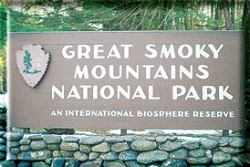The Great Smoky Mountains National Park
This is the place I go for rest and relaxation. When the question arises; where do we go for vacation? My answer is almost always the same. I have not found anywhere that compares to the peaceful beauty of the Smokies.
Most National Parks in the U.S. were set aside from government lands before individuals could claim any ownership. That was not the case with the Smokies. The preservation of the Great Smoky Mountains, Cades Cove, and other surrounding areas as a national park is supported today by millions of people. But, according to Carlos C. Campbell's 1960 book, "Birth of a National Park in the Great Smoky Mountains", the early advocates were few, while the initial resistance was great.
There were many adversaries to developing a national park. These opponents consisted of businessmen who were more interested in developing the Smokies as a national forest rather than a national park; the distinction being that national forest status would still allow the area’s resources to be exploited (the main resource being timber), political foes and cultural foes that wanted the Smokies to remain as they were.
Lucky for us that people like Mrs. Willis P. Davis of Knoxville, TN. saw the grandeur of the area and started a movement to change the entire complex to a National Park. The federal government was reluctant to buy land for the park but with the help of the states of Tennessee and North Carolina, and individuals, including John D. Rockefeller. Jr. who contributed $5,000,000 in matching funds for the project, we are all able to enjoy the splendor and beauty of the Great Smoky Mountain National Park. The initial cost to purchase the land for the park was over 12 million dollars and on June 15, 1934 the Great Smoky Mountains National Park was established. Land acquisition continued and covers 520,269 acres. On September 2, 1940, President Franklin Roosevelt officially dedicated the park.
The first year the park opened it had over 1 million visitors. Today nearly 10 million people visit the park a year which about doubles the visitors of any other National Park. The original charter states that there would never be an entrance fee to the park which may be one of the reasons for the high number of visitors. The reasons for free entry to the national park date back at least to the 1930s. The states of Tennessee and North Carolina, as well as local communities, paid to construct Newfound Gap Road (US 441). When the state of Tennessee transferred ownership of Newfound Gap Road to the federal government in 1936, it stipulated that no toll or license fee shall ever be imposed to travel the road. But with all these visitors there also comes problems. Besides being the most visited park it is also the most polluted park. With all the automobles and traffic jams in and around the park, the Smokys are getting smokier. In fact the Great Smoky National Park has almost as much smog as L.A. According to the National Park website "most pollution originates outside the park and is created by power plants, industry, and automobiles". For more information about pollution in the Smokies visit the National Park Service website.
The Great Smokies got its name from the dense mist that often overs it. The Cherokee Indians called them shaconage, (shah-con-ah-jey) or "place of the blue smoke". Before all the smog, the smoke-like fog that hangs over the Smoky Mountains came from rain and evaporation from trees. On the high peaks of the Smokies, an average of 85 inches of rain falls each year, qualifying these upper elevation areas as temperate rain forests. The park straddles the Tennessee-North Carolina border and forms part of the state's Blue Ridge region. The mountain range extends the entire length of the park and contains some of the highest peaks of eastern North America. Clingmans Dome (6643 ft), located in Tennessee, is the park's highest peak.
The Great Smoky Mountains are among the oldest mountains in the world, formed perhaps 200-300 million years ago. There are 100 species of native trees, more than 200 species of birds, 66 types of mammals, 50 native fish species, 39 varieties of reptiles, and 43 species of amphibians. Among the wildlife in the park are black bear, bobcat, deer, red and gray fox, wild turkey, and ruffed grouse. For the angler, you can fish for smallmouth bass, rock bass, rainbow trout or brown trout. Fishing is allowed within the park from sunrise to sunset. A valid Tennessee or North Carolina state fishing license is required. Pick up a copy of fishing regulations at the visitor centers.
The NPS offers talks, slide shows, films, guided nature and history walks, and evening campfire programs. Together with the Great Smoky Mountains Natural History Association, they provide a wealth of year-round classes and programs covering almost every aspect of the park's history. The park also hosts a variety of events, including Old Timers' Day, a quilt show, storytelling and molasses making. Spring through October, park employees don the dress of 19th-century settlers and demonstrate how mountain pioneers lived. At Oconaluftee Mountain Farm Museum, they spin wool, weave cloth, forge tools, make sorghum into molasses, and perform and explain the daily tasks of mountain people. At Mingus Mill and Cable Mill, millers grind corn into cornmeal and wheat into flour.
Despite the easy driving access to the park, the majority of the 520,269 acres are wilderness and waiting for you to explore.
Don't Trust Your Vehicle Navigation System/GPS - This is a recommendation from the NPS website.
"Vehicle Navigation Systems and GPS units may provide inaccurate
information in the mountains - sending drivers the wrong way on one-way
roads or leading them to dead ends in remote areas. Free park road maps
are available in park visitor centers.
(http://www.nps.gov/grsm/planyourvisit/directions.htm)"
this website conforms with W3C standards











